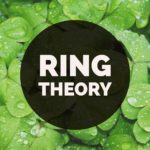A Ring Has Infinitely Many Nilpotent Elements if $ab=1$ and $ba \neq 1$

Problem 543
Let $R$ be a ring with $1$.
Suppose that $a, b$ are elements in $R$ such that
\[ab=1 \text{ and } ba\neq 1.\]
(a) Prove that $1-ba$ is idempotent.
(b) Prove that $b^n(1-ba)$ is nilpotent for each positive integer $n$.
(c) Prove that the ring $R$ has infinitely many nilpotent elements.
Sponsored Links
Contents
Proof.
(a) Prove that $1-ba$ is idempotent.
We compute
\begin{align*}
(1-ba)^2&=(1-ba)(1-ba)=1-ba-ba+b\underbrace{ab}_{=1}a\\
&=1-ba-ba+ba=1-ba.
\end{align*}
Thus, we have $(1-ba)^2=1-ba$, and hence $1-ba$ is idempotent.
(b) Prove that $b^n(1-ba)$ is nilpotent for each positive integer $n$.
As a lemma, we show that $(1-ba)b=0$.
To see this, we calculate
\begin{align*}
(1-ba)b=b-b\underbrace{ab}_{=1}=b-b=0.
\end{align*}
Now we compute
\begin{align*}
b^n(1-ba)\cdot b^n(1-ba)&=b^n\underbrace{(1-ba)b}_{=0 \text{ by lemma}}b^{n-1}(1-ba)=0.
\end{align*}
This proves that $b^n(1-ba)$ is nilpotent.
(c) Prove that the ring $R$ has infinitely many nilpotent elements.
In part (a), we showed that the element $b^n(1-ba)$ is a nilpotent element of $R$ for each positive integer $n$.
We claim that $b^n(1-ba)\neq b^m(1-ba)$ for each pair of distinct integers $m, n$.
Without loss of generality, we may assume that $m > n$.
We state simple facts which are needed below.
We have
\begin{align*}
a^nb^n&=1\\
a^nb^m&=b^{m-n}.
\end{align*}
Note that $a^nb^n$ and $a^nb^m$ look like
\[aa\cdots a\cdot bb\cdots b.\]
Then we use the relation $ab=1$ from the middle successively, and we obtain the right-hand sides.
Now we prove that $b^n(1-ba)\neq b^m(1-ba)$ for each pair of distinct integers $m, n$.
Assume on the contrary $b^n(1-ba)= b^m(1-ba)$ for $m > n$.
Then we multiply by $a^n$ on the left and get
\begin{align*}
a^n b^n(1-ba)= a^n b^m(1-ba).
\end{align*}
Using the facts stated above, we obtain
\[1-ba=b^{m-n}(1-ba).\]
Note that the left-hand side is a nonzero idempotent element by part (a).
On the other hand, the right-hand side is nilpotent by part (b).
Since a nonzero idempotent element can never be nilpotent, this is a contradiction.
Therefore, $b^n(1-ba)\neq b^m(1-ba)$ for each pair of distinct integers $m, n$.
Hence there are infinitely many nilpotent elements in $R$.
 Add to solve later
Add to solve later
Sponsored Links











